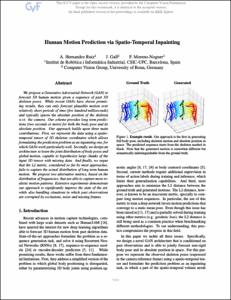Mostra el registre d'ítem simple
Human motion prediction via spatio-temporal inpainting
| dc.contributor.author | Hernández Ruiz, Alejandro José |
| dc.contributor.author | Gall, Juergen |
| dc.contributor.author | Moreno-Noguer, Francesc |
| dc.contributor.other | Universitat Politècnica de Catalunya. Doctorat en Automàtica, Robòtica i Visió |
| dc.contributor.other | Institut de Robòtica i Informàtica Industrial |
| dc.date.accessioned | 2020-05-14T05:57:01Z |
| dc.date.available | 2020-05-14T05:57:01Z |
| dc.date.issued | 2019 |
| dc.identifier.citation | Hernandez, A.; Gall, J.; Moreno-Noguer, F. Human motion prediction via spatio-temporal inpainting. A: IEEE International Conference on Computer Vision. "2019 IEEE/CVF International Conference on Computer Vision (ICCV)". Institute of Electrical and Electronics Engineers (IEEE), 2019, p. 7133-7142. |
| dc.identifier.isbn | 978-1-7281-4803-8 |
| dc.identifier.uri | http://hdl.handle.net/2117/187445 |
| dc.description | © 2019 IEEE. Personal use of this material is permitted. Permission from IEEE must be obtained for all other uses, in any current or future media, including reprinting /republishing this material for advertising or promotional purposes, creating new collective works, for resale or redistribution to servers or lists, or reuse of any copyrighted component of this work in other works |
| dc.description.abstract | We propose a Generative Adversarial Network (GAN) to forecast 3D human motion given a sequence of past 3D skeleton poses. While recent GANs have shown promising results, they can only forecast plausible motion over relatively short periods of time (few hundred milliseconds) and typically ignore the absolute position of the skeleton w.r.t. the camera. Our scheme provides long term predictions (two seconds or more) for both the body pose and its absolute position. Our approach builds upon three main contributions. First, we represent the data using a spatio-temporal tensor of 3D skeleton coordinates which allows formulating the prediction problem as an inpainting one, for which GANs work particularly well. Secondly, we design an architecture to learn the joint distribution of body poses and global motion, capable to hypothesize large chunks of the input 3D tensor with missing data. And finally, we argue that the L2 metric, considered so far by most approaches, fails to capture the actual distribution of long-term human motion. We propose two alternative metrics, based on the distribution of frequencies, that are able to capture more realistic motion patterns. Extensive experiments demonstrate our approach to significantly improve the state of the art, while also handling situations in which past observations are corrupted by occlusions, noise and missing frames. |
| dc.format.extent | 10 p. |
| dc.language.iso | eng |
| dc.publisher | Institute of Electrical and Electronics Engineers (IEEE) |
| dc.rights | Attribution-NonCommercial-NoDerivs 3.0 Spain |
| dc.rights.uri | http://creativecommons.org/licenses/by-nc-nd/3.0/es/ |
| dc.subject | Àrees temàtiques de la UPC::Informàtica |
| dc.subject.lcsh | Computer vision |
| dc.subject.other | Computer vision |
| dc.subject.other | Pattern recognition. |
| dc.title | Human motion prediction via spatio-temporal inpainting |
| dc.type | Conference report |
| dc.subject.lemac | Reconeixement de formes (Informàtica) |
| dc.subject.lemac | Visió per ordinador |
| dc.contributor.group | Universitat Politècnica de Catalunya. ROBiri - Grup de Robòtica de l'IRI |
| dc.identifier.doi | 10.1109/ICCV.2019.00723 |
| dc.description.peerreviewed | Peer Reviewed |
| dc.relation.publisherversion | https://ieeexplore.ieee.org/document/9008530 |
| dc.rights.access | Open Access |
| local.identifier.drac | 27655416 |
| dc.description.version | Postprint (author's final draft) |
| dc.relation.projectid | info:eu-repo/grantAgreement/MINECO/2PE/MDM-2016-0656 |
| dc.relation.projectid | info:eu-repo/grantAgreement/MINECO/2PE/TIN2017-900-R |
| local.citation.author | Hernandez, A.; Gall, J.; Moreno-Noguer, F. |
| local.citation.contributor | IEEE International Conference on Computer Vision |
| local.citation.publicationName | 2019 IEEE/CVF International Conference on Computer Vision (ICCV) |
| local.citation.startingPage | 7133 |
| local.citation.endingPage | 7142 |


